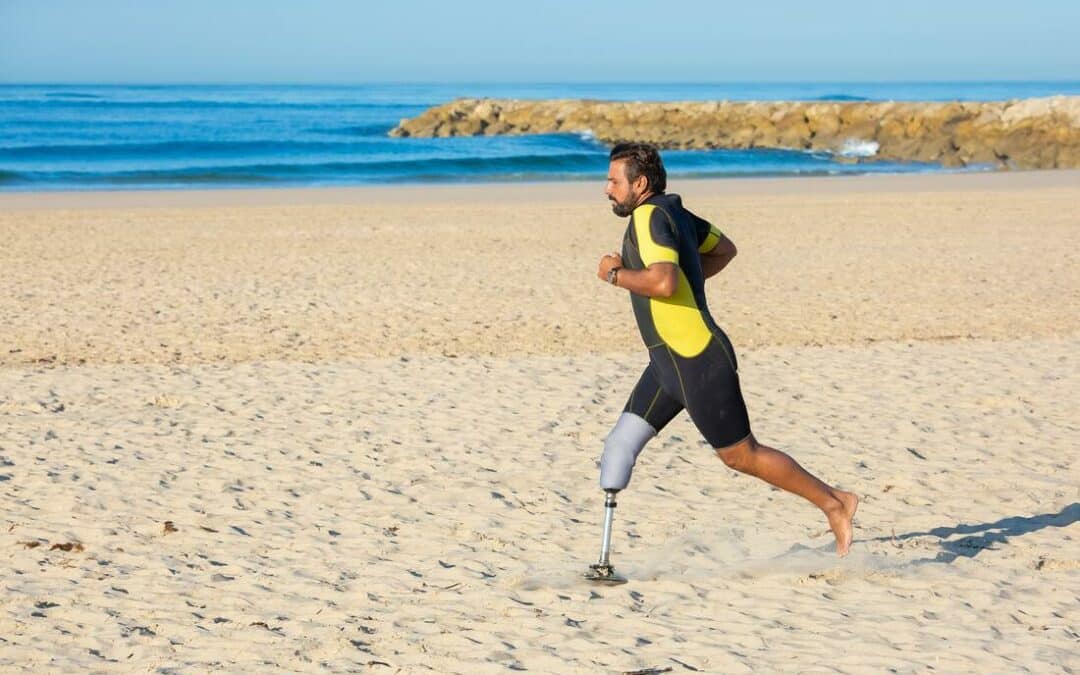Rehabilitation after amputation is a long and laborious process. Generally speaking, the fewer joints that are lost in the amputation, the easier the rehab is.
A below-knee [BKA] prosthesis rehab is a difficult process. There are numerous items to check before prescribing the prosthesis such as the condition of soft tissues on the residual limb, range of motion, and mobility goals to name a few.
It’s best to know what you’re getting into before you begin the rehab program. This article covers the top five things you should be prepared for during your prosthesis rehabilitation.
What Is the BKA Prosthesis Rehab?
The below-knee prosthesis rehab is a specialized program to get amputees back to regular functioning with their new prosthetic leg.
It involves re-learning to walk, run, pick up objects from the floor and return to life as much as possible!
There are distinctive protocols to follow for the various types of lower limb prostheses. Some of the commonly used prostheses types include the preparatory prosthesis, total surface or the patella tendon weight-bearing prosthesis, and sports prosthesis for athletes and runners.
The rehab begins with counseling and physical assessment and ends with the patient being completely independent in performing his or her daily activities.
In the beginning, the main portion of the rehab is conducted at the clinics under a professional Prosthetist’s supervision.
As you progress and get better at balancing yourself and understanding the techniques, your appointments with the physical therapists [PTs] are spaced out and you’re given more tasks to do at home.
Overview of BKA Prosthesis Rehab The rehab begins soon after the amputation surgery or after you get your first prosthesis fitted.
The process looks different for each person but some general guidelines can help you prepare for what’s next.
Here’re five things you should expect from a BKA prosthesis rehab:
1. A Multidisciplinary Rehab Team
Your BKA prosthesis rehab team primarily has Prosthetists and physical therapists but physicians, nurses, and psychologists will also be a part of your multidisciplinary team.
Your rehab doesn’t only mean training you to walk independently. Rather it also involves helping you emotionally cope with the change, getting your entire body adjusted to the prosthesis, and keeping an eye on the internal body systems.
For that, an entire team of experts is required.
Your physical therapist will also recommend support groups and community rehab sessions where you’ll interact with other patients going through a similar rehab program.
2. BKA Prosthesis Rehab Will be Ongoing
The BKA prosthesis rehab process is a long one.
Initially, you’ll need a cane or a walker to assist you in walking on your prosthesis. After sufficient rehab, you can reach a point where you no longer need assistive devices and you can easily walk on your legs but that’s not where the rehab journey ends.
You should get comfortable with the fact that the below-knee prosthesis rehab will be ongoing for months.
You won’t need aggressive pain management treatments or hour-long gait training once you’re past the initial phase, but you’ll need to come in for regular checkups for your stump and the prosthesis to make sure that your leg is in good operating condition.
How long it’ll take varies from patient to patient; so you should ask your physical therapist for the estimated time.
3. The Rehab Depends on Your Level of Activity
The BKA prosthesis rehab is highly customized to each patient and it depends on what your daily routine is like.
So before beginning the rehab, your physical therapist will conduct a detailed assessment of your activities, functions, endurance levels and gait pattern then set up your goals and expected outcomes.
The rehab is designed differently for different people. For example, there’ll be higher intensity and fast-tracked programs for the relatively young and active adults or veterans as compared to the elderly or chronically ill patients.
So don’t be alarmed if your rehab program isn’t the same as someone else’s, even if the two cases look the same to you. PTs are experts in physical rehab and they’ll develop a program best suited to your needs.
4. It’s Going to Be Painful
You should brace yourself for a physically, mentally, and emotionally draining journey.
Re-learning to walk and to do all the things that you did before takes effort, time and a lot of strength. You’ll deal with issues related to your stump, sweating, prosthesis damage, and phantom limb pain.
The good news is that it’ll get better with suitable pain management protocols. And with the right team of Prosthetists and PTs, you’ll be on the other side sooner than later. But the process will test your limits and unfortunately, there’s no avoiding that.
5. Rehab Continues Outside the Clinic as Well
You’ll spend a few hours at most at the PT clinic. After that, the rest of the rehab is continued at home.
Your doctors and PTs will give you a few tasks to do at home; such as home exercises for strength, stretching, weight shifting maneuvers, massaging the stump, and a pain management routine.
There’ll be several precautions to follow as well and these’re just as critical as the active exercises. Your BKA prosthesis rehab will be a full-time job in the beginning, and then it’ll become a part of your routine as time goes on.
We Offer Expert BKA Prosthesis Rehab
These are some of the general things you can expect from a rehab program. But it’s good to remember that each person has a unique experience and you shouldn’t compare your progress or program with anyone else’s.
We’ve got an experienced team for BKA prosthesis rehab. With us, you’ll have access to various experts under one roof because we’ve got Prosthetists, physical therapists, nurses and more all working in the same clinics.
Reach out to us if you’ve got a new prosthesis fitted for your lower limb or if you want a customized rehab program to improve your activity level.




